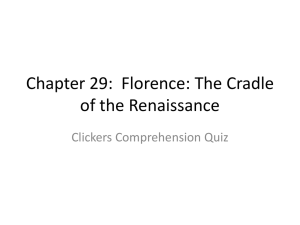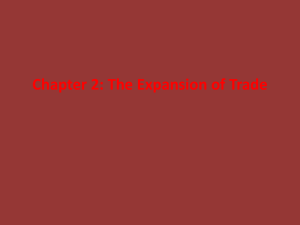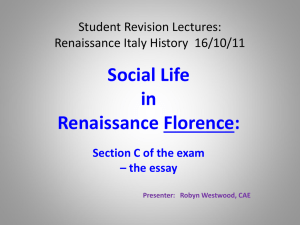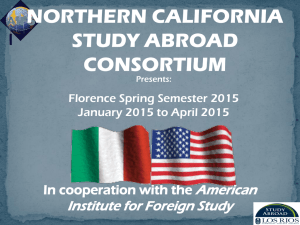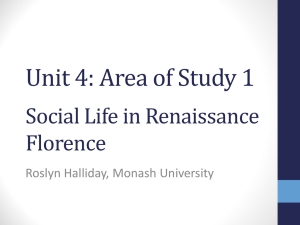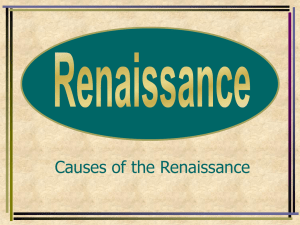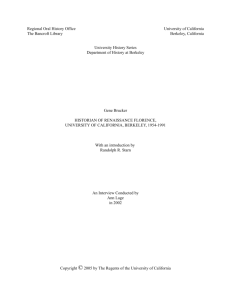Renaissance Florence Social Life
advertisement
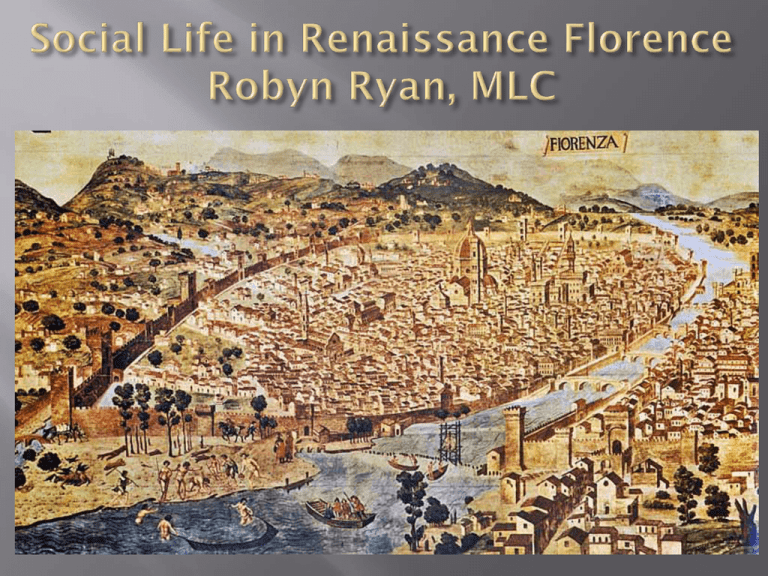
Physical perspective – localised and inward looking rather than globalised and outward looking Religion – as major force shaping a Florentine’s understanding of the world and their actions Personal identity and position – membership and responsibility to such communities as kin, friends, neighbourhood, parish, guild or city accepted as more important in defining an individual than personal character or needs Personal connections and networks more important for individuals given the dangers and insecurities of the period and because our modern community ‘safety net’ only just developing An incomplete and distorted window to the past – wealthy and male residents have left records but many other voices unheard; records can have particular perspectives and purposes that need to be evaluated BUT a wonderful opportunity for people in the past to come alive and speak to us ; to make connections across time Key knowledge: The social structures of Florence during the Renaissance The social map of Florence and how it reflected social identity, wealth, gender and class relationships The importance of aspects of social life such as family, marriage, dowries, charity, social legislation and festivals to the life of the city Key skills: Investigation and reporting on the importance of social life Analysis of visual and written evidence Synthesis of evidence to draw conclusions Examination and evaluation of relevant historiography Family Neighbours Friends Residents on the margins Biological - kin links but could also include links by marriage Spatial – individual households, networks of households in neighbourhoods or areas of the contado; collective identity Language - large number of Italian terms describing blood and marriage relationships – casa, nazione, progenia, famiglia Across time and generations Multiple dimensions - personal identity, social status, economic wealth, political power Met a range of needs – material, economic, social, political, personal - but accompanied by expectations on members Family relationships complex - economic and political as well as social and emotional dimensions Patriarchal and hierarchical Marriage – to serve interests of family rather than meet needs of partners ‘The family forms an island of certainty in a treacherous sea who should live under the one roof ‘ ‘Keep business in the family rather than bringing in external partners.’ ‘Duty requires helping them not even so much with money, as with sweat and blood, and by any means one can, even to giving your life for the honour of the house and its members.’ Leon Battista Alberti ‘Families and lineages ‘give and receive in legitimate marriages, [and] through their marriage alliances and their love [toward each other] encompass a good part of the city, whence, being related by marriage, they charitably assist each other, conferring upon each other advice, favours, and assistance, which, in the course of life, results in benefits, advantage, and abundant fruits.’ Palmieri ‘I sent the marriage broker to him to tell him of my intentions, and I did so in order to acquire his good will and a marriage alliance with him, so that he would be obligated to work on my behalf for a reconciliation with the Corbizi.’ Buonaccorso Pitti Relations between elders and younger family members – always cordial and with elders wielding power? Gender relations - a passive role of women? Emotional dimension to marriage and family? A guarantee of personal and economic security? Negative consequences of family allegiance ? ‘Membership of the local parish church, of a guild, or a confraternity, even of a state, was far less significant to individuals than their membership of a family.’ Family was ‘the centre of his life’, the ‘heart of his identity’ Hole ‘The household was the first focus of emotional and sentimental energies; it was also a distinct group with its own economic basis and its own sphere of political and social activity. Sometimes it was, or gave the appearance of being, a largely selfregarding group, immersed in its own concerns and those of its descendants.’ Kent ‘In an age when life was so tenuous and uncertain, the family bond was a source of material and psychic comfort, a measure of security in a dangerous world.’ Brucker The 2 primary defining relationships for a Florentine were his family and his city Trexler ‘In an age when life was so tenuous and uncertain, the family bond was a source of material and psychic comfort, a measure of security in a dangerous world.’ Brucker To what extent did family provide security and support in Renaissance Florence? 3-4 possible sections: • Identity, position, prestige, security – advantages and disadvantages, reference to primary sources and historical opinions • Political - advantages and disadvantages, reference to primary sources and historical opinions • Economic - advantages and disadvantages, reference to primary sources and historical opinions • Other factors also important – wealth, class, gender, locality, friends, inclusion? Political, economic, social and religious aspects of life manifested in physical location A physical manifestation of family and friends, collective identity and solidarity No sections of the city were reserved exclusively for the rich, no ghettoes inhabited solely by the poor. Each district was a mélange of palace and cottage, of cloth factory and retail shop, of parish church and monastic foundation. Then, as now, the ground floors of elegant palaces were rented out to shopkeepers and artisans; rich bankers and industrialists lived on streets inhabited by shoemakers, stonemasons, indigent cloth workers, and prostitutes. This pattern was a result of the disorderly character of Florence’s expansion, and also of social tradition…’ Gene Brucker Renaissance Florence Neighbourhood and family connections not a guarantee of support The close proximity of neighbours could lead to issues over property, tax etc Personal enmities within a neighbourhood could have negative financial and political consequences ‘Keep your affairs secret from your neighbours.’ Morelli ‘Florence did not divide itself up according to wealth and occupation.’ Eckstein Neighbourhoods provided a ‘bastion of security and stability in this volatile urban milieu.’ Brucker ‘Neighbourhoods…provided most goods and services required in daily life. To acquire basic necessities, emotional as well as economic, one was rarely required to leave one’s parish, gonfalone, or quarter of the city.’ Parishes were ‘the departure and terminal point for most manifestations of public unity’ Trexler ‘The Florentine’s sense of neighbourhood varied according to class, his status, and his sense of the utility of the local bonds in the attainment of specific objectives.’ ‘To acquire the basic necessities , emotional as well as economic, one was rarely required to leave one’s parish, gonfalone, or quarter of the city… One’s working community, social neighbourhood, and ancestral district were likely to occupy the same geographical space.’ Weissman Trexler minimises influence of neighbourhood, arguing that Florentines saw themselves as belonging to 2 key groups: family and the city. Eckstein, Murphy, Kent , Molho, Brucker, Cohn and Weissman acknowledge the key importance of neighbourhood along side other factors 1. ‘A Florentine citizen’s neighbourhood provided security, prosperity and power.’ Discuss with reference to primary and secondary sources. 3 possible sections: • Security – for and against, with primary examples and historical opinions • Prosperity – for and against, with primary examples and historical opinions • Power – for and against, with primary examples and historical opinions 2. In his Ricordi the Florentine merchant Giovanni Morelli advised his sons: to become familiar with the men of substance in your neighbourhood … Discuss how the social map of Florence reflected social identity. (2005) Examiner’s comments: A number of students struggled with the term ‘social map’. The point of reference here was the gonfalone. High-scoring responses discussed how the gonfalone gave meaning to social identity, given that political eligibility and taxation were decided at this local level. They also argued that social identity could be attained beyond the gonfalone through friends, business associates and marriage connections. The following introduction set the parameters for a high-scoring response: The social map of Florence not only reflected but reaffirmed one’s social identity in Renaissance Florence. The gonfalone, the social hub of political and economic life, not only offered a sense of identity, of lineage, tradition and honour, but also social ties such as parenti, amici, vicini which were equally important to one’s social identity Possible 3 section structure? A period of hazards and dangers with few supportive public institutions and services Both formal, overt , and informal networks Some connections of equals, some hierarchical patron/client Both horizontal and vertical connections Friendships and patron/ client relationships had political, economic, social, security, prestige and emotional elements A system of exchanges - mutual responsibilities, obligations and benefits ‘Fortunate and affluent [rich] men are indeed extremely useful friends, not so much because they will help you with their wealth and power directly, but because, as I have found by experience… they can show you the way to acquaintance with all lesser and ordinary persons. ‘ ‘We find that there is really nothing more difficult in the world than distinguishing true friends amid the obscurity of so many lies, the darkness of people’s motives and the shadowy errors and vices that lie about us on all sides. ‘ Alberti, 1430s ‘Let me warn you again that in our city of Florence wealth is conserved only with the greatest difficulty. This is due to the frequent and almost continual wars of the Commune, which have required the expenditure of great sums, and the Commune’s imposition of many taxes and forced loans. I have found no better remedy for defending myself than to take care not to gain enemies, for a single enemy will harm you more than four friends will help…’ Giovanni Rucellai Zibaldone, 1460 Connect yourself by marriage with those who are in power… and if you cannot arrange this, then make him [the man of influence] your friend by speaking well of him, by serving him in whatever way you can… Seek his advice… Show him your trust and friendship. Invite him to your house, and act in ways that you think will please him and will dispose him benevolently toward you. Always keep on good terms with those in power. Test your friend a hundred times… before you trust him, and do not trust him to such an extent that he can be the cause of your undoing. G. Morelli, Ricordi Cosimo was ‘especially inclined towards sculpture and showed great favour to all worthy craftsmen, being a good friend of Donatello and all sculptors and painters; and because in his time the sculptors found scanty employment, Cosimo in order that Donatello’s chisels might not be idle, commissioned him to make the pulpits in bronze in S of his 4 assistants… He also befriended Marsiglio, son of Ficino, a man of good talent and carriage and learned in Greek and Latin. His means were small, and to keep him from poverty Cosimo bought him a house in Florence and a farm at Careggi, Lorenzo and the doors of the sacristy. He ordered the bank to pay every week enough money to Donatello for his work and for that giving him thus income sufficient to allow him to live with one or two companions, and generally to serve his need. Vespasiano da Bisticci (Life of Cosimo de Medici) Better to be friends with the wealthy than the poor but be careful. ‘They treat your loans as gifts and regard your promises as obligations.’ ‘One has to be far seeing … in the face of frauds, traps and betrayals.’ Alberti ‘Test your friends a hundred times.’ Da Certaldo ‘Believe little and trust less.’ ‘You have everything to gain from managing your affairs secretly. And you will gain even more if you can do it without appearing secretive to your friends.’ Guicciardini Positive, co-operative, valuable: On the case of Bartolemeo Cederini who lacked family or neighbourhood support ‘Friendship would have constituted the most significant social bond to Florentines such as Cederini.’ FW Kent Negative , competitive and detrimental: ‘Florence was a veritable cauldron of suspicion, mistrust, and envy, fuelled by the struggles for wealth, status and reputation.’ G Brucker ‘The essential feature of the Florentine social bond was its agonistic character. By this I mean that personal relations were perceived as being, at the one and the same time, competitive encounters occurring between adversaries and supportive encounters occurring between friends sharing numerous common interests, goals and bonds.’ Weissman 1. Alberti commented that ‘nothing except virtue itself is more important than friendship.’ To what extent was friendship important to the individual Florentine? Possible 3 section structure: 2. Weissman argued that ‘the essential feature of the Florentine social bond was its agonistic [combative, strained, competitive] character.’ To what extent do you agree with this view of friendships in Renaissance Florence? Possible 3 section structure? Exiled and disgraced family members – usually men Women – prostitutes, widows and nuns Orphans Male youth Homosexuality The poor Foreigners Servants and slaves Jews Identity, support, security, inclusion Exclusion, alienation and marginalisation By way of public justice and ritual; spectacles, entertainments and processions; communal regulation and legislation; confraternities; charity Festivals: ‘Pilgrimages and processions, feasts and festivals, and moments of ritual inversion and collective celebration offered ceremonial alternatives to the competitive and richly textured social worlds of Florence, allowing Florentines opportunities to reconstruct, reshape, if only for a brief, precious moment, their community.’ Weissman p. 41 Prostitution: ‘Although both honour and religion sternly condemned the prostitute, commerce with her had little stigma… prostitution [was] a necessary evil that served public hygiene, as did a sewer. … City fathers allowed districts of toleration. The trade protected the established sexual order, as it distracted men from seducing chaste women… Prostitutes’ customers did no harm as the women had no more shame to lose.’ Kohen and Kohen p. 281 Male youth and social control: ‘…the ambiguous, fluid, nature that Renaissance culture ascribed to adolescence, whilst troublesome in some ways, could also be put to use. The unsettled shifts from virtue to violence and back again helped express and manage, if not resolve, some of the tensions entrenched in the society.’ Kohen and Kohen p. 197 ‘Recent scholarship has focused less on class distinctions and more on the bonds (patron-client relations; neighbourhood, parish and confraternal associations) that linked together the members of this community.’ To what extent was Florence an inclusive society? (2012) Possible 3 section structure? How did the society of Renaissance Florence or Venice use social conventions and relationships to encourage civic harmony? Answer in relation to the social life of EITHER Florence OR Venice. (2011 HTAV sample exam) Possible 3 section structure? Family Neighbours Friends Inclusion vs marginalisation G Brucker (ed) (1967) Two Memoirs of Renaissance Florence: The Diaries of Buonaccorso Pitti and Gregorio Dati G Brucker (ed) (1971) The Society of Renaissance Florence: A Documentary Study G Brucker (2005) Living on the Edge in Leonardo’s Florence RE Chamberlin (1982) The World of the Italian Renaissance N Eckstein (1995) The District of the Green Dragon: Neighbourhood life and social change in Renaissance Florence L Frieda (2012) The Deadly Sisterhood: A story of women, power and intrigue in the Italian Renaissance R Goldthwaite (1968) Private Wealth in Renaissance Florence: A study of 4 families R Hole (2006) Renaissance Italy FW Kent (1977) Household and Lineage in Renaissance Florence: the family life of the Capponi, Ginori and Ruccellai FW Kent (1990) Bartolemeo Cederini and His Friends: Letters to an obscure Florentine E and T Kohen (2001) Daily Life in Renaissance Florence M Murphy The Gonfalone of the Red Lion in 1427 J Najemy (2008) A History of Florence, 1200-1575 R Trexler(1991) Public Life in Renaissance Florence

